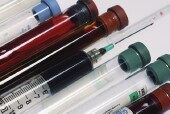
WEDNESDAY, Sept. 15 (HealthDay News) — When people with chronic kidney disease and type 2 diabetes take certain anemia drugs, the level of hemoglobin cells in their blood should go up.
But a new study finds that if those levels don’t increase by much, these “poor responders” experience a significantly increased risk of heart problems and death.
Reporting in the Sept. 16 issue of the New England Journal of Medicine, a team of international researchers says that those who had the worst response to erythropoiesis-stimulating agents (ESAs) — drugs that include Aranesp, Epogen and Procrit — had a 31 percent rise in the risk of cardiovascular complications and a 41 percent increased risk of death.
“For people who have chronic kidney disease, I think this is further evidence that we have to be extremely cautious when we use ESAs. There is a potential for harm. The patients who respond poorly are the ones who get the most drug, and we may be putting them at increased risk,” said the study’s lead author, Dr. Scott Solomon, director of noninvasive cardiology at Brigham and Women’s Hospital and an associate professor of medicine at Harvard Medical School in Boston.
“What we can’t determine from this study is if these patients had worse outcomes because they were sicker to begin with, or because they got more of the drug, or some combination of the two,” added Solomon.
When someone has kidney disease, the kidneys may not produce enough of the hormone erythropoietin to prevent anemia, a deficiency in red blood cells. Symptoms of anemia include fatigue and pale skin, and it can even contribute to heart disease, according to the U.S. National Institute of Diabetes and Digestive and Kidney Diseases.
ESAs were developed to replace the missing erythropoietin in kidney patients and stimulate red blood cell production. But these drugs can cause serious, even life-threatening complications in some patients. Because of this, the U.S. Food and Drug Administration requires manufacturers to include a warning about the risks.
The current study is a secondary analysis of a randomized, double-blind, placebo-controlled study done in 24 countries from 2004 to 2009. All of the study volunteers — 1,872 in all — had type 2 diabetes and chronic kidney disease.
The study volunteers were randomly assigned to receive either 0.75 micrograms of darbepoietin alfa (Aranesp) per kilogram of body weight or a placebo. In people who didn’t respond well to the initial dose of the drug, the dose was repeated after two weeks. After that, hemoglobin levels were monitored and doses adjusted based on an individual’s hemoglobin levels, reported the study.
In the initial analysis of these study volunteers, the researchers found no reduction in the risk of death or of cardiovascular or kidney problems in those taking the drug compared to those on placebo. But they did see a significant increase in the risk of stroke. Solomon said there was only a slight, “unimpressive” increase in quality of life for those taking the ESA.
At the same time, other studies have been finding an increased risk of heart problems in people taking ESAs. Solomon’s team wanted to know why some people might be at greater risk than others.
In a sub-analysis of the initial study, they divided the group into four smaller groups based on their response to darbepoietin alfa, which is how they found the increased risk of death and cardiovascular events in people who responded poorly to the drug.
Solomon said he thinks this effect would likely be seen in other ESAs, not just darbepoietin alfa. Amgen, the maker of Aranesp, provided funding for the study.
“This study helps clarify some of the confusion from previous studies. When you isolate who are the people who got into trouble, it was people who wouldn’t respond to ESAs. I think it helps clarify how to use ESAs. If I see that you don’t respond, there may be something else going on with you, and I need to give you some special attention because you’re at greater risk of having a bad outcome,” said Dr. Robert Provenzano, chair of the department of nephrology at St. John Providence Health System in Detroit.
But, if you respond normally to ESAs, he said, the drugs may improve your quality of life when the medication is adjusted to keep your hemoglobin levels between 10 and 12.5 mg/dL.
Solomon said he wasn’t sure if the modest benefit seen in patients was worth the potential increase in stroke risk. Provenzano countered that such a decision needs to be individualized based on the effects of the anemia, along with other aspects of the patient’s life.
If you take this medication, Provenzano suggested asking your doctor where you fall on the continuum of response and whether you’re in a high-risk group.
More information
Learn more about anemia and kidney disease from the U.S. National Institute of Diabetes and Digestive and Kidney Diseases.

